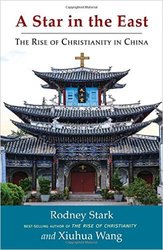Rodney Stark and Xiuhua Wang’s new book, A Star in the East, combines data from a major study on religion in China conducted during the past decade together with keen sociological insights in order to explain the factors behind China’s phenomenal church growth.
In their investigation into China’s “religious awakening,” Rodney Stark and Wang Xiuhu use statistical analysis to substantiate claims of Christianity’s rapid growth – from just over one million Protestants and 3.2 million Catholics in 1950 to slightly over 60 million Christians by 2007, and to show how this growth is taking place among both rural peasants and the well-educated in China (albeit for different reasons).[1]
Looking back over the past century, Stark and Wang point out that Christianity in China before 1949 was primarily an urban phenomenon. Although Catholics outnumbered Protestants overall, more Christians in the coastal provinces were Protestant. After 1949 Catholicism declined due to its dependence upon ordained clergy and its organizational loyalty to Rome. Widespread spiritual revival and aggressive church planting by rural believers in the years following Mao’s death in 1976 combined to create a spiritual powerhouse in the countryside. During this time, according to Stark and Wang, the Gospel spread primarily along relational lines.
Today the church’s spiritual center of gravity is shifting back to the cities. Stark and Wang attribute Christianity’s growth among educated Chinese to a crisis of “cultural incongruity.” This crisis they describe as “a conflict between the cultural assumptions of modernity and those of traditional religious culture,” resulting in spiritual deprivation. A way of resolving this conflict, seen not only in China but in other urbanizing Asian societies as well, is to reject traditional religions such as Buddhism and to embrace Christianity, which is viewed as better equipped to answer the pressing existential questions brought to light by modernity.
Stark and Wang’s statistical treatment adds both credibility and clarity to the often anecdotal accounts of church growth in contemporary China. Their theories about why this growth has taken place shed new light on the nature of the church’s remarkable expansion. Their helpful study also suggests new directions for research for those engaged in the study of Chinese Christianity.
For more on this book, see Joann Pittman's review "The Star in the East: The Rise of Christianity in China" published July 6, 2015 on The Gospel Coalition's website.
Image credit: Gaylan Yeung

Brent Fulton
Brent Fulton is the founder of ChinaSource. Dr. Fulton served as the first president of ChinaSource until 2019. Prior to his service with ChinaSource, he served from 1995 to 2000 as the managing director of the Institute for Chinese Studies at Wheaton College. From 1987 to 1995 he served as founding …View Full Bio
Are you enjoying a cup of good coffee or fragrant tea while reading the latest ChinaSource post? Consider donating the cost of that “cuppa” to support our content so we can continue to serve you with the latest on Christianity in China.
